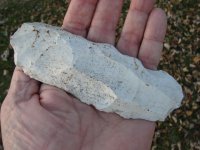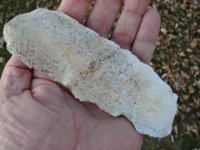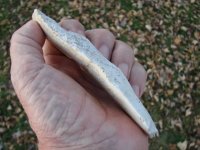I walked out into a freshly picked bean field yesterday looking for signs of an old house site. Field about 1mi. west of the W. Okaw/Kaskaskia River junction. No detector, just scouting. Field needed chiseled and rained on as it was still trashy. Found a rim of a crock, a piece of glass and a piece of a dish so I figure the old house was in that area. Spotted something white and figured another dish piece but was surprised with this blade. Burlington flint. Closest source is 100 mi. west on the IL River. These are usually labeled "paleo" but how can you tell for sure? It's a large tool for this flint poor area, that's for sure. Note the rust marks. Old plow strikes that left a little steel on the flint that then rusted. Gary






Upvote
0




